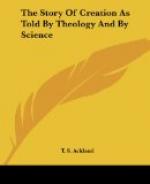Another point which this view fails to explain, is the determination of the line of development in particular directions at different periods. At one time it is most marked in fishes, at another in reptiles, at another in mammals. How is this to be accounted for?
4. The experience of cattle-breeders does not warrant the assumption that the principle of natural selection has more than a limited operation. No case has as yet been brought forward in which varieties have been produced which were not capable of interbreeding. Apart from their experience there is not a particle of evidence in favour of the assertion that races which cannot be made to breed together can be descended from a common stock. The unlimited application of this principle is therefore a pure assumption.
5. To this must be added the circumstance that no authenticated instance of variation by natural selection can be brought forward. It is true that this is not a very important argument, because our knowledge of those classes of animals in which natural selection could act is even now very incomplete; and our knowledge of their past history is still more limited, so that we are not in a condition to prove a negative. But in such a case as this the onus of proof should surely lie on the other side. It is for those who would assert the theory to bring forward positive proof of it. There is, however, one point in Mr. Darwin’s view of domesticated animals which tells against his theory. The cat remains unchanged, because from its vagrant habits man has no control over its pairing [Footnote: Darwin’s “Animals and Plants,” vol. ii. p. 236.]. Now considering the variety of conditions under which cats exist, here is surely a great opening for natural selection. But it has produced no results.




